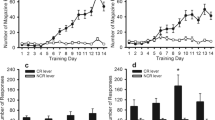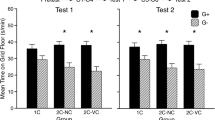Abstract
The influence of genotype on the rewarding and locomotor activating effects of morphine and ethanol was examined in the place conditioning paradigm. Two inbred mouse strains (C57BL/6J and DBA/2J) were exposed to a differential conditioning procedure in which each mouse received four pairings of a distinctive floor stimulus with IP injection of morphine (0, 2.5, 5 or 10 mg/kg) or ethanol (0, 1, 2, 3 or 4 g/kg). A different floor stimulus was paired with saline. Conditioning trials lasted 30 min and each experiment concluded with a floor preference test in the absence of drug. In accord with previous studies, morphine evoked a dose-dependent increase in activity during conditioning that was greater in C57BL/6J mice than in DBA/2J mice. In contrast, ethanol produced a dose-dependent increase in activity that was greater in DBA/2J than in C57BL/6J mice. Both strains showed conditioned place preference with morphine, but only the DBA/2J strain showed conditioned place preference with ethanol. No conditioned place aversion was seen. With both drugs, stronger place preference conditioning was obtained in DBA/2J mice, supporting the general conclusion that sensitivity to drug reward is influenced by genotype. The fact that the same genotype is more sensitive to the rewarding effects of two different drugs supports theories postulating commonality in the biological mechanisms of drug reward. Although the outcome of the ethanol study supports predictions of the psychomotor stimulant theory of addiction concerning the relationship between drug-induced activation and reward, the outcome of the morphine study does not. The direction of the strain difference in conditioned place preference is opposite to what might be predicted on the basis of strain differences previously reported in drug consumption and preference studies, suggesting that genetic differences in drug consumption may not accurately reflect postabsorptive motivational effects of drug.
Similar content being viewed by others
References
Belknap JK (1990) Physical dependence induced by the voluntary consumption of morphine in inbred mice. Pharmacol Biochem Behav 35:311–315
Belknap JK, O'Toole LA (1991) Studies of genetic differences in response to opioid drugs. In: Crabbe JC, Harris RA (eds) The genetic basis of alcohol and drug actions. Plenum Press, New York, pp 225–252
Belknap JK, Belknap ND, Berg JH, Coleman R (1977) Preabsorptive vs postabsorptive control of ethanol intake in C57BL/6J and DBA/2J mice. Behav Genet 7:413–425
Belknap JK, Coleman RR, Foster K (1978) Alcohol consumption and sensory threshold differences between C57BL/6J and DBA/2J mice. Physiol Psychol 6:71–74
Belknap JK, Noordewier B, Lame M (1989) Genetic dissociation of multiple morphine effects among C57BL/6J, DBA/2J and C3H/HeJ inbred mouse strains. Physiol Behav 46:69–74
Bovet D, Bovet-Nitti F, Oliviero A (1969) Genetic aspects of learning and memory in mice. Science 163:139–149
Cappell H, LeBlanc AE (1977) Gustatory avoidance conditioning by drugs of abuse: relationships to general issues in research on drug dependence. In: Milgram NW, Krames L, Alloway TM (eds) Food aversion learning. Plenum Press, New York, pp 133–167
Carr GD, Fibiger HC, Phillips AG (1989) Conditioned place preference as a measure of drug reward. In: Liebman JM, Cooper SJ (eds) Neuropharmacological basis of reward. Oxford, New York, pp 264–319
Crabbe JC (1989) Genetic animal models in the study of alcoholism. Alcohol: Clin Exp Res 13:120–127
Crabbe JC, Alpern HP (1973) A comprehensive analysis of single-trial and criterion maze learning in three inbred strains of mice. Behav Biol 9:681–693
Crabbe JC, Johnson NA, Gray DK, Kosobud A, Young ER (1982) Biphasic effects of ethanol on open-field activity: Sensitivity and tolerance in C57BL/6N and DBA/2N mice. J Comp Physiol Psychol 96:440–451
Crabbe JC, McSwigan JD, Belknap JK (1985) The role of genetics in substance abuse. In: Galizio M, Maisto SA (eds) Determinants of substance abuse: biological, psychological, and environmental factors. Plenum Press, New York, pp 13–64
Crabbe JC, Phillips TJ, Kosobud A, Belknap JK (1990) Estimation of genetic correlation: Interpretation of experiments using selectively bred and inbred animals. Alcohol Clin Exp Res 14:141–151
Cunningham CL (1981) Spatial aversion conditioning with ethanol. Pharmacol Biochem Behav 14:263–264
Cunningham CL (1991) Pavlovian drug conditioning. In: van Haaren F (ed) Methods in behavioral pharmacology. Elsevier, Amsterdam (in press)
Cunningham CL, Prather LK (1990) Ethanol-induced conditioned place preference in mice: role of conditioning trial duration. Soc Neurosci Abstr 16:755
Cunningham CL, Hallett CL, Niehus DR, Hunter JS, Nouth L, Risinger FO (1991) Assessment of ethanol's hedonic effects in mice selectively bred for sensitivity to ethanol-induced hypothermia. Psychopharmacology 105:84–92
Dworkin SI, Smith JE (1988) Molecular mechanisms of drug reinforcement-current status. In: Harris LS (ed) Problems of drug dependence. NIDA Research Monograph No. 90, Rockville, MD, pp 266–274
Elmer GI, Meisch RA, George FR (1987) Differential concentration-response curves for oral ethanol self-administration in C57BL/6J and BALB/cJ mice. Alcohol 4:63–68
George FR (1987) Genetic and environmental factors in ethanol self-administration. Pharmacol Biochem Behav 27:379–384
George FR (1990) Genetic approaches to studying drug abuse: correlates of drug self-administration. Alcohol 7:207–211
Goodwin DW (1979) Alcoholism and heredity: a review and hypothesis. Arch Gen Psychiatry 36:57–61
Horowitz GP, Whitney G (1975) Alcohol-induced conditioned aversion: genotypic specificity in mice(mus musculus). J Comp Physiol Psychol 89:340–346
Hunt T, Amit Z (1987) Conditioned taste aversion induced by self-administered drugs: paradox revisited. Neurosci Biobehav Rev 11:107–130
Lawley SI, Kantak KM (1990) Postconditioning effects of magnesium on cocaine conditioned place preference in mice. Pharmacol Biochem Behav 36:531–538
LeMoal M, Martinez JL, Berman C, Koob GF (1989) Comparison of learning abilities in inbred and recombinant inbred strains of mice. Soc Neurosci Abstr 15:774
Li T-K, Lumeng L, McBride WJ, Waller MB (1981) Indiana selection studies on alcohol-related behaviors. In: McClearn GE, Dietrich RA, Erwin VG (eds) Development of animal models as pharmacogenetic tools. NIAAA Research Monograph No. 6, Rockville, MD, pp 171–191
Linakis JG, Cunningham CL (1979) Effects of concentration of ethanol injected intraperitoneally on taste aversion, body temperature, and activity. Psychopharmacology 64:61–65
Lubow RE (1973) Latent inhibition. Psychol Bull 79:398–407
McClearn GE, Rodgers DA (1959) Differences in alcohol preference among inbred strains of mice. Q J Stud Alcohol 20:691–695
McClearn GE, Rodgers DA (1961) Genetic factors in alcohol preference of laboratory mice. J Comp Physiol Psychol 54:116–119
Mucha RF, Walker MJ (1987) Aversive property of opioid receptor blockade in drug naive mice. Psychopharmacology 93:483–488
Oliviero A, Castellano C, Messeri P (1972) Genetic analysis of avoidance, maze, and wheel-running behaviors in the mouse. J Comp Physiol Psychol 79:459–473
Phillips TJ, Crabbe JC (1991) Behavioral studies of genetic differences in alcohol action. In: Crabbe JC, Harris RA (eds) The genetic basis of alcohol and drug actions. Plenum Press, New York, pp 25–104
Phillips TJ, Belknap JK, Crabbe JC (1991) Use of recombinant inbred strains to assess vulnerability to drug abuse at the genetic level. J Addict Dis 10:73–87
Risinger FO, Dickinson SD, Cunningham CL (1992) Haloperidol reduces ethanol-induced motor activity stimulation but not conditioned place preference. Psychopharmacology 107:453–456
Scoles MT, Siegel S (1986) A potential role of saline trials in morphine-induced place-preference conditioning. Pharmacol Biochem Behav 25:1169–1173
Seale TW, Logan L, Landrum W, Carney JM (1988) Genotypic separation of susceptibility to the motor activity-stimulating action and reinforcing action of cocaine. Soc Neurosci Abstr 14:850
Sherman JE, Hickis CF, Rice AG, Rusiniak KW, Garcia J (1983) Preferences and aversions for stimuli paired with ethanol in hungry rats. Anim Learn Behav 11:101–106
Smith CA, Holman EW (1987) Rewarding and aversive effects of stimulant drugs in infant rats. Pharmacol Biochem Behav 26:211–215
Stewart RB, Grupp LA (1989) Conditioned place aversion mediated by self-administered ethanol in the rat: A consideration of blood ethanol levels. Pharmacol Biochem Behav 32:431–437
Swerdlow NR, Gilbert D, Koob GF (1989) Conditioned drug effects on spatial preference: critical evaluation. In: Boulton AA, Baker GB, Greenshaw AJ (eds) Psychopharmacology (Neuromethods, vol 13) Humana, Clifton, NJ, pp 399–446
Tabakoff B, Hoffman PL (1988) A neurobiological theory of alcoholism. In: Chaudron CD, Wilkinson DA (eds) Theories on alcoholism. Addiction Research Foundation, Toronto, pp 29–72
Upchurch M, Wehner JM (1988) Differences between inbred strains of mice in Morris water maze performance. Behav Genet 18:55–68
Upchurch M, Wehner JM (1989) Inheritance of spatial learning ability in inbred mice: a classical genetic analysis. Behav Neurosci 103:1251–1258
van der Kooy D, O'Shaughnessy M, Mucha RF, Kalant H (1983) Motivational properties of ethanol in naive rats as studied by place conditioning. Pharmacol Biochem Behav 19:441–445
Vezina P, Stewart J (1987) Morphine conditioned place preference and locomotion: the effect of confinement during training. Psychopharmacology 93:257–260
Wise RA (1989) The brain and reward. In: Liebman JM, Cooper SJ (eds) Neuropharmacological basis of reward. Oxford, New York, pp 377–424
Wise RA, Bozarth MA (1987) A psychomotor stimulant theory of addiction. Psychol Rev 94:469–492
Author information
Authors and Affiliations
Rights and permissions
About this article
Cite this article
Cunningham, C.L., Niehus, D.R., Malott, D.H. et al. Genetic differences in the rewarding and activating effects of morphine and ethanol. Psychopharmacology 107, 385–393 (1992). https://doi.org/10.1007/BF02245166
Received:
Revised:
Issue Date:
DOI: https://doi.org/10.1007/BF02245166




